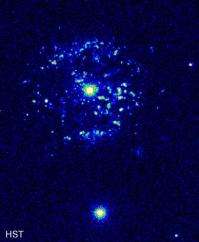January 7, 2010 report
Massive white dwarf in our galaxy may go supernova

(PhysOrg.com) -- A massive white dwarf star in our galaxy may become a supernova several million years from now, and could damage the Earth and possibly destroy life on Earth.
Scientists at the American Astronomical Society's 215th meeting, in Washington DC, said earlier this week that new observations of T Pyxidis in the constellation Pyxis (the compass) using the International Ultraviolet Explorer satellite, indicate the white dwarf is part of a close binary system with a sun, and the pair are 3,260 light-years from Earth and much closer than the previous estimate of 6,000 light-years.
The white dwarf in the T Pyxidis system is a recurrent nova, which means it undergoes nova (thermonuclear) eruptions around every 20 years. The most recent known events were in 1967, 1944, 1920, 1902, and 1890. These explosions are nova rather than supernova events, and do not destroy the star, and have no effect on Earth. The astronomers do not know why the there has been a longer than usual interval since the last nova eruption.
Astronomers believe the nova explosions are the result of an increase of mass as the dwarf siphons off hydrogen-rich gases from its stellar companion. When the mass reaches a certain limit a nova is triggered. It is unknown whether there is a net gain or loss of mass during the siphoning/explosion cycle, but if the mass does build up the so-called Chandrasekhar Limit could be reached, and the dwarf would then become a Type 1a supernova. In this event the dwarf would collapse and detonate a massive explosion resulting in its total destruction. This type of supernova releases 10 million times the energy of a nova.
Observations of the white dwarf during the nova eruptions suggest its mass is increasing, and pictures from the Hubble telescope of shells of material expelled during the previous explosions support the view. Models estimate the white dwarf's mass could reach the Chandrasekhar Limit in around 10 million years or less.
According to the scientists the supernova would result in gamma radiation with an energy equivalent to 1,000 solar flares simultaneously - enough to threaten Earth by production of nitrous oxides that would damage and perhaps destroy the ozone layer. The supernova would be as bright as all the other stars in the Milky Way put together. One of the astronomers, Dr Edward Sion, from Villanova University in Pennsylvania, said the supernova could occur "soon" on the timescales familiar to astronomers and geologists, but this is a long time in the future in human terms.
Astronomers think supernova explosions closer than 100 light years from Earth would be catastrophic, but the effects of events further away are unclear and would depend on how powerful the supernova is. The research team postulate it could be close enough and powerful enough to damage Earth, possibly severely, although other researchers, such as Professor Fillipenko of the Berkeley Astronomy Department, disagree with the calculations and believe the supernova, if it occurred, would be unlikely to damage the planet.
© 2010 PhysOrg.com


















